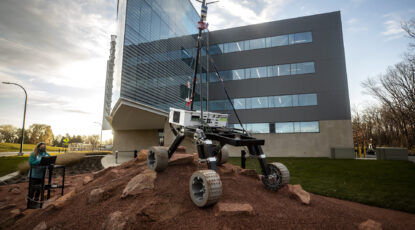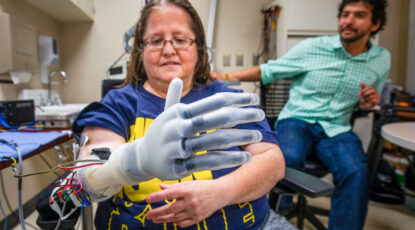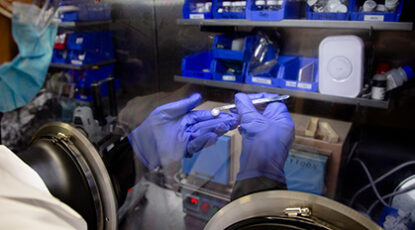-
First-responder robots could team with wildfire fighters
A three-year project funded by a $1 million grant aims to equip bipedal walking robots with the technology to trek in areas that are too dangerous for humans, including collapsed buildings and other disaster areas.
-
‘PrivacyMic’: For a smart speaker that doesn’t eavesdrop
U-M researchers have developed a system that can inform a smart home – or listen for the signal that would turn on a smart speaker – without eavesdropping on audible sound. Phew! We can finally stop whispering all the time.
-
Data is life: Amazon holds clues about climate
Follow Michigan researchers deep into (and above) the Amazon as they collect data, day by day and tree by tree, that could drive a better understanding of the Earth’s climate future.
-
Gaming grad holds two world records for vintage collections
Linda Guillory, an electrical engineer at Texas Instruments, explains how her love of fixing broken video games set her on a course to become a world-renowned gaming collector.
-
Choose your own adventure
Experience an earthquake, frolic on Mars, and chase a robot up the stairs. It’s just another dazzling day at U-M’s Ford Motor Company Robotics Building, now open for mind-bending business.
-
Sticking the landing on Mars: High-powered computing reduces guesswork
NASA’s Mars Perseverance Rover touched down on the Red Planet’s surface Feb. 18. U-M’s Jesse Capecelatro has been working with NASA to better understand what happens during landings when surface particles are stirred up.
-
How to make the robot revolution serve the people
The Ford Robotics Building, at $75 million and 140,000 square feet, is set to open soon. Features include an indoor fly zone for autonomous aerial vehicles, an outdoor playground for walking robots, a high-bay garage for self-driving cars, and more.
-
‘Holy grail’ battery doubles the range of electric vehicles
Lithium metal batteries can double the capacity of today’s standard lithium-ion cells, and much of the existing manufacturing system is primed for production, say experts at U-M. Let’s roll!
-
Destroying PFAS with plasma
When this chemical contaminant is removed from water, it often is placed in landfills only to re-enter the water supply over time. U-M engineers have a plan: Use cold plasma to destroy PFAS rather than just removing it.










